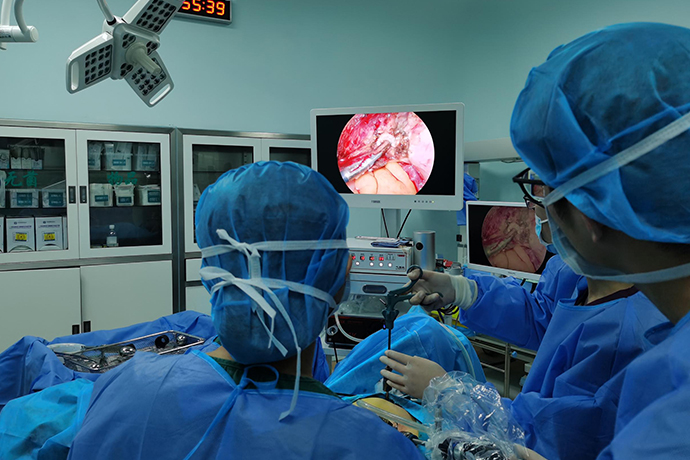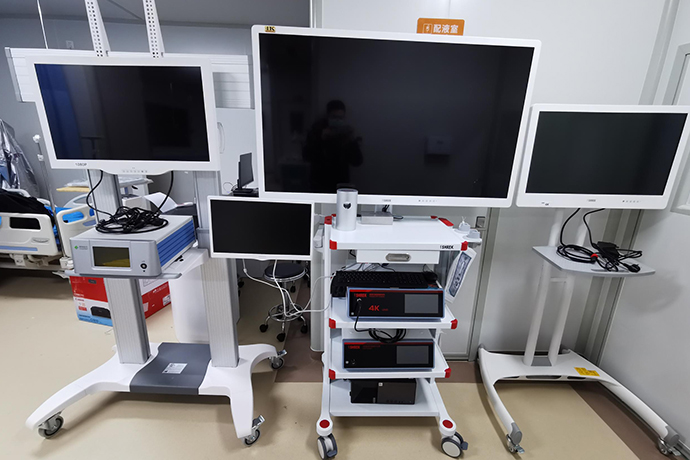【Orthopaedic Arthroscopy】Arthroscopy Repair Techniques of Meniscus Root
Release time: 31 May 2022 Author:Shrek
Because the posterior meniscus is relatively rich in blood supply and has a high probability of healing after repair, it is recommended for patients with acute, traumatic posterior meniscal tears, or symptomatic chronic posterior meniscal tears without severe bone loss. Meniscus root repair is a good choice for middle-aged and young patients with arthritis.

preoperative examination
All patients underwent knee anteroposterior, Rosenberg, sunrise, full-length and lateral X-ray examinations of both lower extremities.
MRI is routinely used for the evaluation of meniscal root tears (sensitivity 77%, specificity 72%, positive predictive value 22%, negative predictive value 97%). The following are signs of a torn root.
Meniscus extrusion (>3mm) and coronal edema of the femoral condyle.
Sagittal view shows absence of the posterior horn of the meniscus (ghost sign) or a thin layer of fluid at the root attachment.
If the height is correct, the axial view can also show a dislocated tear fluid dissection at the root and the original attachment site.
Indications/Contraindications
Indications
Acute, traumatic root tears with normal or near-normal cartilage (Outerbridge <3) and narrow joint space (Kellgren- Lawrence <3).
Chronic clinically symptomatic tears in young or middle-aged patients with normal or near-normal cartilage (Outerbridge <3) and narrowed joint space (Kellgren-Lawrence <3).
Contraindications
Patients with poor physical condition (multiple comorbidities or advanced age), patients with advanced osteoarthritis (grade 3 or 4 chondromalacia ipsilateral compartment), and asymptomatic chronic meniscal root tears.
Patients with significantly misaligned lower extremity mechanical axes relative to the affected compartment may have a poor prognosis; correction of the lower extremity mechanical axis should be considered at the same time or prior to meniscal root repair.
Chronic clinically symptomatic tears in young or middle-aged patients with normal or near-normal cartilage (Outerbridge <3) and narrowed joint space (Kellgren-Lawrence <3).
Contraindications
Patients with poor physical condition (multiple comorbidities or advanced age), patients with advanced osteoarthritis (grade 3 or 4 chondromalacia ipsilateral compartment), and asymptomatic chronic meniscal root tears.
Patients with significantly misaligned lower extremity mechanical axes relative to the affected compartment may have a poor prognosis; correction of the lower extremity mechanical axis should be considered at the same time or prior to meniscal root repair.
Surgical methods
Standard anterolateral and anteromedial parapatellar approaches are used, but posteromedial or posterolateral approaches can also be used.
Diagnostic arthroscopy is used to identify accompanying pathological changes in the meniscus, cartilage, and ligaments.
A complete tear of the root was confirmed and the tear pattern was determined (ie, avulsion, radial tear adjacent to the root).
Medial Meniscus Posterior Root Repair Technique
Through the anteromedial approach, use grasping forceps to reduce the root of the meniscus. The most common landmark of the medial meniscal root attachment is the tip of the medial tibial eminence (MTE). The distance from the MTE tip to the center of the root attachment point was 9.6 mm posteriorly and 0.7 mm outward.
In chronic tears, trimming is required from the posterior joint capsule to the root of the injury for anatomical reduction.
Arthroscopic scalpers and radiofrequency probes are used to clean the root attachment and prepare the bony surface for healing.
An incision is made slightly medial to the tibial tubercle and a guide is used to place the first tibial tunnel guide pin and cannulated sleeve behind the root attachment point. The guide wire and hollow sleeve of the second tunnel were placed slightly anterior to the first tunnel using a 5 mm eccentric guide wire. Arthroscopically confirm the position, then remove the guide wire, leaving the cannula in place.
The suturing procedure (two simple sutures) is accomplished through the delivery device via an anteromedial approach. Another approach is established to secure the root during suturing. The first suture is behind the root and the second suture is in front of the root. During the suturing procedure, a cannula was used to ensure that no soft tissue bridge was formed in front of the retropatellar fat pad.
If the suture cannot be passed through the standard anterior approach due to a narrow intercondylar fossa, intact cruciate ligament, or narrow compartment, a posterior accessory approach may need to be established.
Push the looped wire up the back tunnel and through the tunnel. Repeat this process in the front tunnel.
Back the cannula 1-2mm before suture to avoid fraying or damaging the suture.
Tie the suture to the metal buckle on the anteromedial aspect of the tibia.
recovery
The patient was unable to bear weight for 6 weeks.
Immediate postoperative physical therapy included early passive exercise with a range of motion within a safe range of 0° to 90° for the first 2 weeks.
After 2 weeks, further increase the knee flexion angle within the tolerance range.
Beginning at week 6, gradually reach full weight bearing.
Avoid deep leg presses and squats with knee flexion greater than 70° for at least 4 months after surgery.
Disclaimer: The texts are taken from Ligetay Medical School II Sanyun College. This article focuses on the popularization of medical knowledge and does not seek any economic benefits. If there is any infringement, please contact us in time.

- Recommended news
- 【General Surgery Laparoscopy】Cholecystectomy
- Surgery Steps of Hysteroscopy for Intrauterine Adhesion
- [Gynecological Hysteroscopy] Techniques for Preventing and Treating Complications of Hysteroscopic Surgery
- [Gynecological Hysteroscopy] Hysteroscopic Adhesiolysis
- [Gynecological Hysteroscopy] IUD Removal under Hysteroscopy